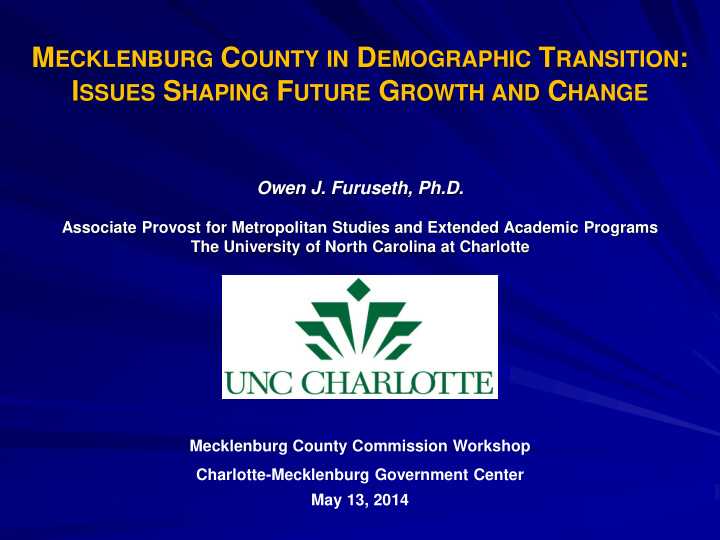



M ECKLENBURG C OUNTY IN D EMOGRAPHIC T RANSITION : I SSUES S HAPING F UTURE G ROWTH AND C HANGE Owen J. Furuseth, Ph.D. Associate Provost for Metropolitan Studies and Extended Academic Programs The University of North Carolina at Charlotte Mecklenburg County Commission Workshop Charlotte-Mecklenburg Government Center May 13, 2014
Framework for the Discussion Demographic Megatrends “The Great State of Mecklenburg” Mecklenburg County’s Role in 21 st Century North Carolina The Mecklenburg County vs. Wake County Comparison Neighborhoods Matter: Demographic Markers and the Future 2
Demographic Megatrends National and international population changes reshape social, economic, and civic life in U.S.A. Multiscalar Impacts: national, state, local Represent opportunities and challenges to decision- makers and community leaders 3
Demographic Megatrends Graying of America (The Population Pyramid becomes a Rectangle) 4
Source : The Pew Research Center, The Next America. 5
Source : The Pew Research Center, The Next America. 6
Source : The Pew Research Center, The Next America. 7
Demographic Megatrends Graying of America (The Population Pyramid becomes a Rectangle) Immigration Driving Demographic Makeover 8
Source : The Pew Research Center, The Next America. 9
America’s 21 st Century Demographic Frame 2005-2050, U.S. population growth (48%) 438 million 82% growth immigrants and their descendants Foreign-Born Population in 2011 Mexico (29%) India (4.6%) Philippines (4.5%) China (4.1%) Vietnam (3.1%) El Salvador (3.1%) Korea (2.7%) 10
Immigrant Overview for Mecklenburg County, 2012 (Foreign-Born equals Immigrant) Total Foreign-Born 13.6% (128,879) Region of Birth Latin America 51.5% Asia 27.3% Europe 10.9% Africa 8.4% North America (Canada) 1.4% Oceania 0.4% Entered U.S. Before 2000 50.7% 2000-2009 43.4% 2010 or later 5.9% Source : U.S. Census Bureau, American Community Survey, 3-year estimates (2010-2012). 11
Demographic Megatrends Graying of America (The Population Pyramid becomes a Rectangle) Immigration Driving Demographic Makeover Browning of America 12
Source : The Pew Research Center, The Next America. 13
Charlotte: Old South to New South City Demographic Megatrends 800000 734,418 (17) 700000 540,828 600000 45.1% 500000 White 395,934 African-American 55.9% 400000 Hispanic 315,474 65.6% Asian 300000 34.2% 67.5% 200000 33.0% 13.1% 31.8% 100000 31.3% 7.8% 5.1% 1.4% .098% 3.7% 1.8% . 076% 0 1980 1990 2000 2010 2012 Census Bureau – Mecklenburg County became a majority minority county 14
“The Great State of Mecklenburg” Political dismissive – pejorative cliché Current and future demographic directions Mecklenburg’s growing dominance and trendsetting 15
Mecklenburg County vs. State Population Trends 1990 2000 2010 2020 2030 Population 511,211 695,370 923,390 1,138,336 1,335,238 County Growth Rate 36.0% 32.8% 23.3% 17.3% NC Growth Rate 21.3% 18.9% 10.9% 10.0% Proportion of State 7.7% 8.6% 9.6% 10.7% 11.6% Population Source : Office of State Management & Budget, Population Estimates and Projections, accessed April 21, 2014. 16
Source : John Chesser, “UNC Charlotte story.” 17
Population Change: Takeaways North Carolina ranked 12 th (3.28%) Half of all the growth since 2010 in Wake and Mecklenburg counties (145,000) Half the counties in North Carolina lost population Mecklenburg County grew faster than any county in the region Charlotte MSA 5 th largest destination for domestic migration 18
Demographic Megatrends Source : U.S. Census Bureau, population estimates. Mecklenburg County is “youngest” county in the region 19
Demographic Megatrends Source : Dr. James H. Johnson, Jr., “Disruptive Demographics: Implications for Workforce Planning and Development,” September 2012. Mecklenburg County among lowest dependency ratios in the State 20
Source : U.S. Census Bureau, American Community Survey, 5-year estimates. 21
College-level Educational Attainment: Take-Aways Mecklenburg population is well above national averages Regional counties are still below the NC average Mecklenburg and Wake Counties lifting state-level educational attainment base 22
Mecklenburg County vs. Wake County Population Trends (percentage change) Mecklenburg Wake County County 1990 511,211 426,311 695,370 627,846 2000 (36.0%) (42.3%) 923,390 900,993 2010 (32.8%) (43.5%) 1,138,336 1,111,847 2020 (23.3%) (23.4%) 1,335,238 1,320,437 2030 (17.3%) (18.8%) Source : Office of State Management & Budget, Population Estimates and Projections, accessed April 21, 2014. 23
Where will Population Growth Occur? 24
Geographic Realities: Mecklenburg vs. Wake County In both, Mecklenburg and Wake County, suburban growth patterns are significant Mirroring other growing metropolitan regions, suburban growth is higher income and lower minority Wake County is 59.4% larger geographically than Mecklenburg County If Wake County was approximate to Mecklenburg County, out- of-county suburban growth would be greater 25
Population Growth and Developable Land Mecklenburg Wake County County Population (July 2014 estimate) 1,008,193 986,692 Population Growth (2014-2030) 34.4% 33.8% Land Area 523.84 sq. miles 835.22 sq. miles Local Governments 7 13 Land Area in Urban Areas (2012) 406.76 sq. miles 300.00 sq. miles Developable Non-Urban Land 117.08 sq. miles 535.22 sq. miles Project Population Growth (2014-2030) 347,045 333,745 Source : Office of State Management & Budget, Population Estimates and Projections, accessed April 21, 2014. 26
Population Growth and Developable Land: Take-Aways Wake County growth on undeveloped land Mecklenburg County growth in mix of undeveloped land and redeveloped areas All municipalities in Mecklenburg County active local plans to strengthen downtowns and neighborhoods Existing neighborhoods matter for future 27
Charlotte-Mecklenburg Quality of Life Study: Toolbox for Neighborhood Enhancement Initiated in 2012, biennial schedule Partnership with Mecklenburg County, City of Charlotte, six towns 464 neighborhood geographies (NPA – Neighborhood Profile Areas) Mean population: 1,900 8 Data Dimensions 82 individual variables 28
Median Household Income: Lower Income Crescent 29
Single Family Property Value 30
Median Household Income and Single Family Residential Property Value Median Household Income R-Squared: 0.551704 p-value (significance): < 0.0001 Single Family Residential Property Value 31
Median Household Income and Residential Renovation Permits Median Household Income R-Squared: 0.211397 p-value (significance): < 0.0001 Residential Renovation Building Permits 32
Median Household Income and New Residential Building Permits Median Household Income R-Squared: 0.0066472 p-value (significance): 0.239438 New Residential Building Permits 33
Median Household Income and New Building Permits 34
Hot Pockets of New Residential Building Permits Higher Income NPA Lower Income NPA 35
Demographic Neighborhood Change Processes Follow broad theoretic models Multi-scalar impacts Neighborhood Quality of Life Assessment Tool 36
Presentation is available at: www.mseap.uncc.edu/presentations 37
Recommend
More recommend